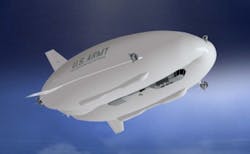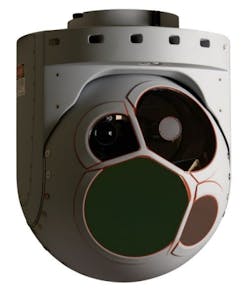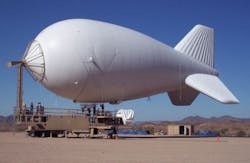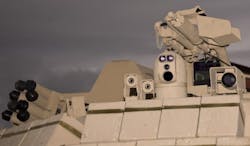Persistent surveillance on a non-satellite budget is goal of U.S. military airship development
“Persistent surveillance is around the clock -- 24/7 -- monitoring for an extended period of time, monitoring that is in stark contrast to that provided by aircraft, which have surveillance-time limitations dictated by fuel consumption/capacity,” says Maj. Robert Rugg, assistant product manager persistent surveillance devices for the U.S. Army Program Manager Robotic and Unmanned Systems office Aberdeen Proving Ground, Md.
There are two main types of lighter-than-air vehicles used or in development for military operations -- airships and aerostats, Browning says. “An aerostat is tethered while an airship is free flying,” he explains.
Two free-flying programs in development are the High Altitude Airship (HAA) being developed by Browning’s team at Lockheed Martin and the Long Endurance Multi-Intelligence Vehicle (LEMV), being designed by Northrop Grumman in Melbourne, Fla., for medium altitudes, Browning says. They are both airship platforms.
Aerostats
The most deployed vehicles at the moment are aerostats, which often are used with unmanned aircraft systems (UASs) or as a relatively inexpensive replacement to UASs to provide non-stop coverage of strategic areas.
“Aerostats are capable of continuous coverage over (typically) a fixed area in a wide range of operational weather conditions,” Rugg says. “UASs have a reduced operational environment and cannot continuously remain in the air for an extended period of time. However, the extended mobility provided by a UAS allows for a better view of a particular point of interest. In this way, each system is able to capitalize on its inherent advantage, while propping up the limiting aspects of the other -- optimally, a force is able to utilize both systems as complementary to each other.
Aerostats and free-flying airships also are under consideration for border control instead of UASs, says Tony White, owner of Galaxy Blimps in Dallas -- www.galaxyblimps.com. A UAS does not work as well on the border due to the coverage advantages that a host of aerostats airships would have, he continues.
While not easy at first to steer aerostats are more rugged than one might think. “We also can launch into heavy winds, while UASs can’t,” White says. Even in 70 knot winds in Afghanistan, aerostats were able to hold their position in the mooring station, White says. Aerostats are not as vulnerable to enemy attack as one might assume, Browning says. “We’re flying at the upper limit to be vulnerable to small arms fire,” he adds.
“Despite the innovative nature of the systems, aerostats, in fact, have the great advantage of payload integration and flight qualification timelines that are much shorter than that of other aircraft,” Rugg continues. “Moreover, aerostats are typically more flexible in terms of the payloads they are able to carry. Weight limitations are the paramount issue with aerostats; some aircraft have lots of available size, weight, and power (SWAP).”
Persistent threat detection
One aerostat program currently seeing action in Iraq and Afghanistan is the Army’s Persistent Threat Detection System (PTDS), which has been deployed in Iraq and Afghanistan during Operation New Dawn and Operation Enduring Freedom respectively, Browning says. PTDS is run by Rugg’s team in Huntsville produced by prime contractor Lockheed Martin.
PTDS is a tethered system, which flies like a kite with no propulsion, Browning says. The system, first deployed by the Army in 2004, is a 74,000-cubic-foot envelope full of helium and aerodynamically-shaped always pointed into the wind with fins and a tail system and is always buoyant, he adds. The maximum altitude is 5,000 feet above ground level, Browning says.
“PTDS has the unique sustained operations capability that exceeds 20 continuous days,” Rugg notes.
The system carries one or two electro-optic/infrared (EO/IR) sensor payloads as well as other communications payloads, Rugg says. The EO sensors are mostly commercial-off-the-shelf (COTS), he adds. The EO/IR payload -- the MX-20 Lite from L-3 Wescam in Toronto, Ontario -- is attached on the underside of the aerostat, Browning says.
The MX-20 is a turret system that uses high-definition technology, says Paul Jennison, vice president of business development for L-3 Wescam. Included in the system is digital infrared capability, a color daylight camera, mono camera for night, and lasers for range finding and illumination -- that illuminates targets for ground for troops who have night vision goggles, he continues.
The only real adjustment made for the aerostat application was adding a heat exchanger for thermal management in the static air, Jennison says. “Our system also has gone through the full spectrum of MIL-STD testing for humidity, salt, fog, and dust environments,” he adds.
The PTDS communication links have extended range for deployed troops, Browning says. The sensor can provide full-motion vision to the warfighter on the ground. “Imagine the value of that to combat teams,” Browning adds.
“Based on experience in theater, a second EO/IR sensor has been added. Furthermore, due to on site weather conditions, lightning detection equipment has been added, as well as the ability to broadcast video to mobile troops carrying OSRVT (One System Remote Video Terminal),” Rugg says. “Additionally, the mooring system has been modularized to allow transport to more remote forward operating bases.”
The ground-control station for an aerostat is typically on site, Rugg says. These ground-control stations are not that different from that of a UAS ground station, and “include such elements as operator consoles, workstations, tactical setup. The operating crew for a ground station is the same crew that launches and recovers the aerostat,” he adds.
Most of the electronics in the ground-control station is COTS, Rugg says. “There are two workstations for command and control of EO/IR sensors, networking equipment, UPS, aerostat flight control and monitoring computer and display as well as an Unattended Transient Acoustic MASINT Sensor (UTAMS) computer. UTAMS is an acoustic fire-detection sensor capable of locating point of impact/origin of rockets, mortars, and improvised explosive devices (IEDs).”
High-altitude airships
Lockheed Martin’s HAA -- being developed for the Army -- will act as a surveillance platform, telecommunications relay, or a weather observer, Browning says. Different electro-optic sensor payloads will be configured for different intelligence, surveillance, and reconnaissance (ISR) missions, he continues. Once it reaches its location it can survey a 600-mile diameter and millions of cubic miles of airspace.
In April 2008, the HAA program transferred from the Missile Defense Agency to the U.S. Army Space and Missile Defense Command, located at Huntsville, Ala. The command designing the HAA to align with the command's mission
“The big thing to understand is that no lighter than airship has ever flown more than a few hours at more than 60,000 feet,” let alone six months, Browning says. Conventional airships have demonstrated days of endurance in the past. Current blimps for sporting events can fly for 12 plus hours, depending on conditions, he adds.
The HAA will be about 500 feet long and 150 feet high, and be airborne for six months or more at a time, Browning says. It will be launched to an area of interest and park there, he continues. It will have a sensor communication link capability for deployed troops on field to get where they want to get to, Browning adds.
“We are currently developing and demonstrating the high altitude airship concept,” Browning says. The demonstration program is called the High Altitude Long Endurance-Demonstrator (HALE-D), he adds.
HALE-D will fly this summer air at an altitude of 60,000 ft and operating for a couple weeks using small, modest payload consistent with the demonstration, Browning says.
Free flying aircraft steer and navigate from one location to another so the all-electric HALE-D will need to operate at neutral buoyancy, Browning says. Goodyear blimps are always scary, taking off with heavy with fuel, which then burns, making the aircraft more light and buoyant.
The long-term operational goal -- beyond the HALE-D is large with more than ton of payload onboard the HAA, Browning says. The large payload berth provides a lot of flexibility in payload design and capability, he continues. “It can really open the imagination of the sensor designer,” Browning adds.
The sensor technology is already available on a lot of aircraft, Browning says. However as with some existing airborne and spaceborne platforms the biggest challenge is reliability. Once the system is launched it won’t be brought down for several months, so you need sensors that last in tough environments.
The HALE-D sensors include a Thales MMAR modem, an L-3 Communications mini CDL, and an electro-optical system from ITT Geospatial Systems in Rochester, N.Y., Browning says.
ITT provided a long focal-length panchromatic electro-optical (EO) camera with GPS/Inertial Navigation System (INS) and pointing capability for the HALE-D program, says David A. Parkes, senior business development manager at ITT Geospatial Systems.
“An unmanned high-altitude platform does bring unique challenges in designing EO solutions,” Parkes says. “First, it’s very high flight altitudes bring very cold temperatures as low as -50 degrees Celsius and little air, which makes it challenging to both start up and maintaining proper electronics temperatures. It is more space-like than airborne. The ascent to these high altitudes also drives the need for all components to be able to outgas, so they are not damaged (e.g. optical lens). The second challenge is that current payload capacities for high altitude platforms are relatively small, which drives the need for very light weight and low power payloads.”
“The objectives and funding of this EO system were primarily for functional demonstration on this exciting high-altitude platform,” Parkes continues. “This drove a highly COTS-based solution. Future high-altitude EO systems will require designs that provide higher performance and high reliability that will leverage space systems designs without space system costs.”
Long-endurance airships
Northrop Grumman’s LEMV program completed its critical design review (CDR) six months after signing the agreement with the U.S. Army. Under that agreement the company will build three airships with 21-day persistent ISR capability, according to a Northrop Grumman release. Northrop Grumman officials declined to be interviewed for this story.
"While LEMV is longer than a football field and taller than a seven-story building, it utilizes approximately 3,500 gallons of fuel for the air vehicle to remain aloft for a 21-day period of service, that's approximately $11,000 at commercial prices.
"We'll have hull inflation in the spring and first flight of the airship test article by mid-to-late summer,” he says. Upon completion of the development ground and flight testing phase, we expect to transition to a government facility and conduct our final acceptance long endurance flight just before year's end. In early 2012, LEMV will participate in an Army Joint Military Utility Assessment in an operational environment."
Northrop Grumman's industry team includes Hybrid Air Vehicles, Ltd. of the England, Warwick Mills, ILC Dover, AAI Corp., SAIC in McLean, Va., and a team of organizations from 18 U.S. states and three countries. In addition to leading the program, Northrop Grumman leads the system integration, and flight and ground control operations for the unmanned vehicle.





